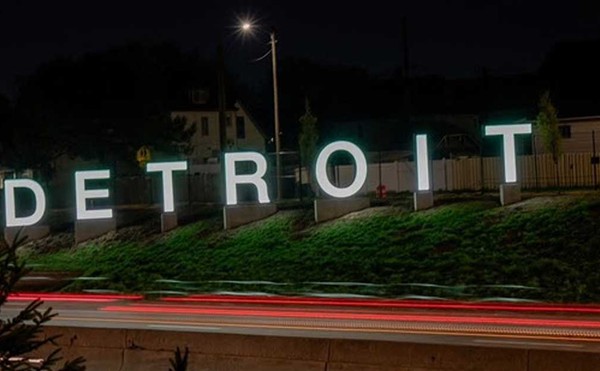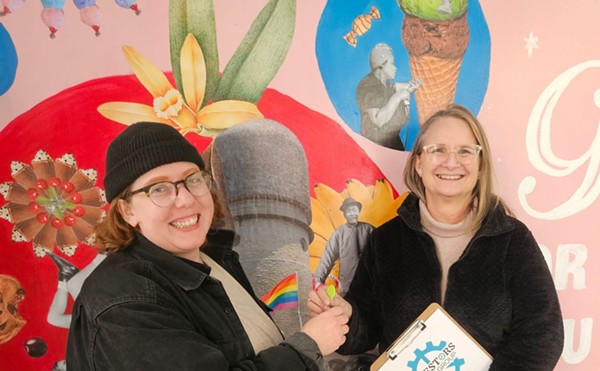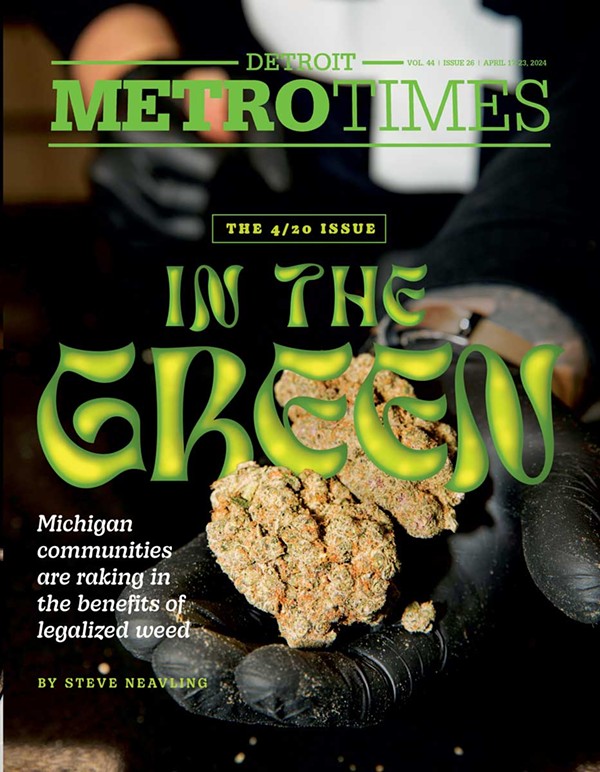Mich. Ave. “Slaughtered”
I would like to thank Metro Times for its continued coverage of Corktown and southwest Detroit. However, I was slightly stunned by the opening sentence in Jane Slaughter’s review of Slow’s Bar BQ (“Heat of the moment,” Metro Times, Oct. 12): “There’s hardly a more blighted strip of street north of New Orleans than Michigan Avenue.” Besides its heartless flippancy toward victims of the Gulf Coast hurricane tragedy, it is obviously a gross exaggeration, one I would expect more from a suburbanite riding a shuttle to a Tigers game that from a southwest Detroit resident. Over the last several years, there has been an incredible amount of private and public investment pumped into Michigan Avenue, in both Corktown and Ms. Slaughter’s neighborhood farther west. Over the past year or so, six new businesses, one being Slow’s Bar BQ, have opened up on Michigan Avenue in Corktown alone — specifically between the Lodge and I-96/I-75 — including another popular restaurant, the Brooklyn Street Grille. In addition to John Lopez’s wine bar that was mentioned in the review, there are two restaurants and a bookstore now in the works on Slow’s block alone!
There have been significant investments in Michigan Avenue’s infrastructure as well. Beautiful new light poles have been installed thanks to the city of Detroit and the Michigan Department of Transportation (MDOT), and eight blocks of sidewalk enhancements have been completed in partnership with MDOT and the Greening of Detroit; four more are in the pipeline for next year (as reported in Metro Times). MDOT is also currently studying how to make Corktown’s Michigan Avenue more pedestrian- and bike-friendly; its report will be released in November. Because Michigan Avenue is a designated State Heritage Route, it is eligible for special funding to implement the recommendations that will come out of MDOT’s study. Finally, the city of Detroit and the Empowerment Zone funded eight façade-improvement grants to Michigan Avenue businesses, which is why new awnings, windows and signage seemingly sprouted up overnight along this stretch of the street.
When Tiger Stadium closed back in 1999, it was common to hear how Michigan Avenue and Corktown were sure to crumble. But the opposite has been true. Businesses that had become stagnant due to an overdependence on Tiger fans have reinvented themselves (see the Lager House). Old stalwarts have retained loyal patrons (see Nemo’s). Neighborhood hangouts have new regulars (see LJ’s Lounge). I would put the entertainment options one can find along Michigan Avenue up against almost any stretch of road in Michigan. And the transformation continues, thanks to new kids like Slow’s. It is very easy to make flip remarks about blight; it’s much more difficult to transform an entire stretch of a major corridor that, like most of Detroit, has seen decades of severe disinvestment. It takes time, leaps of faith, and support. —Kelli B. Kavanaugh, deputy director, Greater Corktown Development Corporation, [email protected], corktowndetroit.org
Class act
Re: “How poverty becomes a trap” (Metro Times, Oct. 12), I want to thank Keith Owens for finding a way to help people understand that American poverty is self-sustaining because it involves much more than a simple lack of money. That column is so much like the conversations I have had, before and after Katrina, with people — usually well-meaning, middle-class and (often, but not always) white — about what it means to be truly poor, and what living in constant survival mode is really like, something with which I have had way too much experience.
I often tell folks, who are often just as earnest as the person who wrote in to Mr. Owens, that the reason most black people are not as successful as Oprah Winfrey is the same reason most white people are not as successful as Bill Gates. It’s an imperfect analogy in many respects, but it gets the basic message across that dramatically raising one’s socioeconomic status on a permanent basis is beyond most human beings.
And there are plenty of people who still believe that people who are poor have never tried to not be. Most of us know that in this society, the work and resource acquisition necessary to change one’s class status is difficult and exhausting. Somehow, though, some people can’t make the next leap, to the conclusion that changing status is particularly hard for folks whose day-to-day life is already loaded with struggle after maddening struggle to get the simplest things accomplished.
But that kind of nonthinking prevails when our country, and its media, are unwilling to point out and talk about the very real, dirty, scary, exhausting, painful experience that is poverty in America, and the incredibly creative and courageous ways in which the poor stay afloat, if only for another day. Without seeing and understanding this, those without the experience of poverty are left to draw the wrong conclusions. The poor, after all, aren’t the only ones with limited education. —Leah Samuel, Pittsburgh, Pa.
Thoughtful remarks
Mr. Owens’ column was a very thoughtful and thought-provoking piece. Because I work with the poor (and mentally ill) here in Detroit, and because New Orleans is my adopted spiritual home, I have been anguished for the past month about the city and its people. Mr. Owens does us a great service to bring the subject of poverty in focus, even though neither he nor I are one of “them.” Ironically, I wonder if the things that make New Orleans great, its musical and cultural traditions, would have been born were it not for the personal struggles to live with or escape poverty. —Wayne Isbell, Redford
A reading list
Dear Mr. Owens: Thank you for writing a column that describes the challenges facing families and individuals living in severely distressed neighborhoods. It’s refreshing to read a column that addresses the issue so clearly and effectively.
For a better understanding of the issues, readers might want to read When Work Disappears: The World of the New Urban Poor by William Julius Wilson and The American Dream: Three Women, Ten Children, and the Nation’s Drive to End Welfare by Jason DeParle. —Donna Givens Williams, Detroit
Understand the poor
Thank you so much for this article. I’ve been discussing questions like these with my 25-year-old nephew. He went to Dillard University, is living in Dallas, and has spent a lot of the last couple of months helping Katrina survivors find shelter. His recent lament was that many of the people he has helped treated him and the Red Cross workers very rudely. He said they seemed very angry. I suggested a pause and a deep breath and he will easily be able to feel their pain and frustration. I cautioned him not to take any of it personally.
I plan to e-mail him your story. I know it will help him understand a little more. —Linda M. Bruton, West Bloomfield
Gotta have heart
What a wonderful tribute to Council President Maryann Mahaffey (“Fare thee well,” Metro Times, Oct. 5). While many other news sources’ reports or opinions about her retirement seemed de rigueur, this came across as truly heartfelt.
Good job, Metro Times! —Judy Lessl, Fraser
Social support
Thanks for your farewell article to Maryann Mahaffey. I love the title, too, by the way. There are just a few items you miss the mark on that I point out for future reference. Social work practitioners don’t stop being social workers. Social work practice is rooted in political thought and social change. It just happens that our profession has tentacles that are far-reaching and allow us to connect with various components of our discipline’s vastness. Maryann has made it a point of always stating she is a “social worker first,” and has been considered by the National Association of Social Workers and other Michigan social work organizations as the top social worker in the state. She also often gives lectures for various graduating classes discussing the political history of our profession — about which she is most knowledgeable.
You say in your article, “As the years went on, criticism of her politics grew.” In actuality, in the year a very popular Kwame Kilpatrick ran for mayor, Maryann won a whopping 139,000 votes to the Mayor’s 109,000. In my observations, support for Maryann’s position on the issues actually grew given the throngs of supportive calls we received. While people were opposed to an occasional specific stance she took and expressed it quite openly, never in my years with her office have I met anyone who shunned her for her being an unabashed progressive. —Terry Lynn Howcott, M.S.W., legislative analyst, Detroit City Council President Maryann Mahaffey
Sour note
To L.M. Smith (who doesn’t have the guts to write his whole name) regarding his review of Devendra Banhart’s album Cripple Crow (Metro Times, Oct. 12): Real nice the review. And who do you think you are, Mr. Smith? Not even skilled enough to take songs in the second level or not even able to filter the skim, huh? All right, Mr. Smith, try another job. And if you want Devendra to go back wherever he comes from, why don’t you go to hell and learn what talent is before you write your sore crap. Art is something you should drop and go sell pork chops by Wall Street! —Nicole Nall, La Riche, France
Errata: Last week’s Night & Day item about an exhibit of IWW art and memorabilia at the University of Michigan should have referred to the organization as the Industrial Workers of the World. Also, due to an editorial error, a letter in last week’s letters section, “Chamber orchestration” should have been attributed to Matt Ferguson of Lansing, editor of michiganliberal.com.
Send comments to [email protected]





